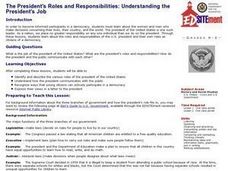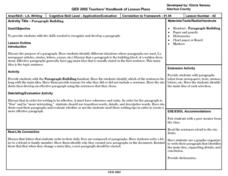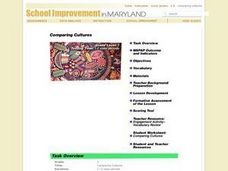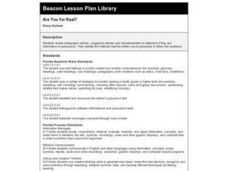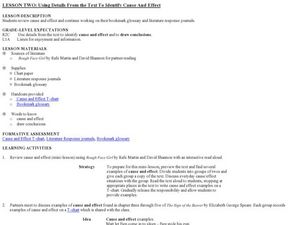Curated OER
Introduction To Literary Analysis
Explore the fascinating ways in which authors use specific literary devices to create interesting and realistic texts. Using non-fiction articles with the subject of rogue waves, an excerpt from The Perfect Storm, by Sebastian Junger,...
Curated OER
We Live in an International Community
Learners locate the different countries from which their clothing originates. Using a blank map, they identify and color in those areas.
Curated OER
Developed or Undeveloped?
Students watch slides of other countries to identify and discuss factors that make a country developed or developing. They create a product that shows their view of developed and undeveloped.
Curated OER
Owl Pellets
Learners dissect owl pellets, and compare, identify and record rodent skeletal parts. They compare rodent skeletal diagrams to human skeletal diagrams.
Curated OER
Decision Making
Students, in groups, explore different ways to solve problems. They identify positive and negative consequences and make a group decision.
Curated OER
The President's Roles and Responsibilities: Understanding the President's Job
Students examine the roles and responsibilites of the president of the U.S. They identify and discuss the three branches of U.S. government, view and discuss a White House Photo essay online, and create a class book entitled, 'If I Were...
Curated OER
Paragraph Building
Build the skills your budding authors need to develop to compose well-structured paragraphs. Give them the topic sheet (included here), and have them write a cohesive paragraph using the ideas listed. Consider having them include two...
Curated OER
History of Political Parties in the U. S.
Twelfth graders name some of the parties in the political system of the United States. They identify the two main parties along with key information, issues, events, elections and/or people for each system. They then break into groups...
Curated OER
Orienteering: Map Skills
Students use a map to locate six specific landmarks on a course using a map. They identify how maps can help us and write a paragraph describing how to get from one landmark to another on the map.
Curated OER
Literature Review Paragraph
Tenth graders review the structural elements of a literary paragraph and organizational paragraph formats. They author a paragraph examining and reviewing a piece of literature currently being read in class. Students peer-review the...
Curated OER
Garden Variety Geometry
A home improvement plan can help adult learners preparation for the GED exam. They review vocabulary, prepare diagrams, complete a worksheet, calculate perimeters and analyze how to approach a story problem. They identify many geometry...
Curated OER
What do Maps Show: How to Read a Topographic Map
Students identify the characteristics of topographical maps. Using examples, they practice reading them and describing the information they gather from them. They also discover how to use the website from the U.S. Geological Survey.
Curated OER
Discussing Poetry In Class
Students investigate syllabic metre and rhyming techniques by analyzing poetry. In this language arts lesson, students read the poem Considering the Snail and discuss the nature and mood of the poem with their classmates. Students...
Teacherfiles
Basic Story Map
Here’s an all-purpose story map template that readers can use to keep track of books read for class, of independent reading, and even for stories planned. Users identify the title, author, major characters, setting, and events from the...
Curated OER
Classroom Potlatch
Elementary schoolers study the history and purpose of potlatches. The listen to two stories about potlatches, then design a potlatch that they will host for their family members. They must come up with the gifts they would give, the...
Curated OER
The Emperor and the Kite
Fourth graders develop critical listening skills and answer four questions related to the story, THE EMPEROR AND THE KITE. They identify the main idea and recall a question that involves making a judgment.
Curated OER
If I Were A Statue
Students locate and identify statues in their local community. They write what they would see or hear and how they would feel if they were statues. They illustrate their stories.
Curated OER
Comparing Cultures
Young readers compare two stories/cultures, identifying how they are alike and different. They share their own version of a well-known story and adapt it to another culture. They explain their adaptations.
Utah Education Network (UEN)
Simplifying Algebraic Expressions
Sixth and seventh graders explore the concept of simplifying algebraic expressions. They review the order of operations and apply properties to simplify and compare them. The author suggests using a "Boxes Game" as a motivator to get...
Curated OER
Writing to Argue
Students analyze speeches for or against continued military presence in Iraq. In this writing to argue lesson, students listen to speeches given before Parliament to identify rhetorical devices used. Students compare techniques used and...
Curated OER
No Regrets: a Poetry Analysis
Young scholars read a poem and use the TPCASTT strategy for analysis. In this poetry analysis lesson, students journal about their future goals and read John Updike's "Ex-Basketball Player." Young scholars discuss the purpose of the poem...
Curated OER
Are You For Real?
Students try to find newspaper and magazine articles that are informative or persuasive. They practice determining the differences between the two types of articles. They identify the devices authors use to persuade the audience.
Curated OER
Cracking the Genetic Code
Students investigate different purposes for manipulating DNA. After reviewing the structure and functions of DNA, students explore topics related to the use or manipulation of DNA and the potential benefits and problems, later making a...
Curated OER
Using Details From the Text To Identify Cause and Effect
Students word in groups to come up with cause and effect situations based on texts they are reading. In this cause and effect lesson plan, students record these in their literary response journals.







